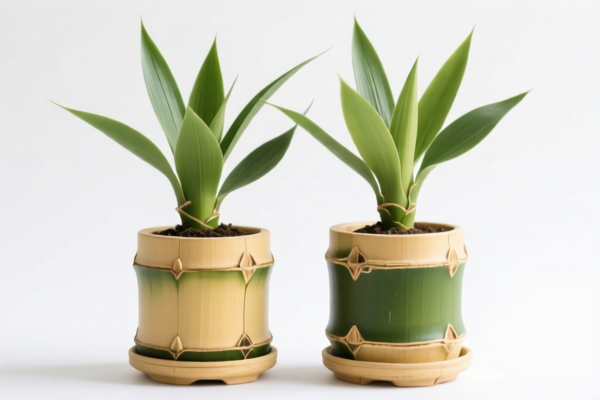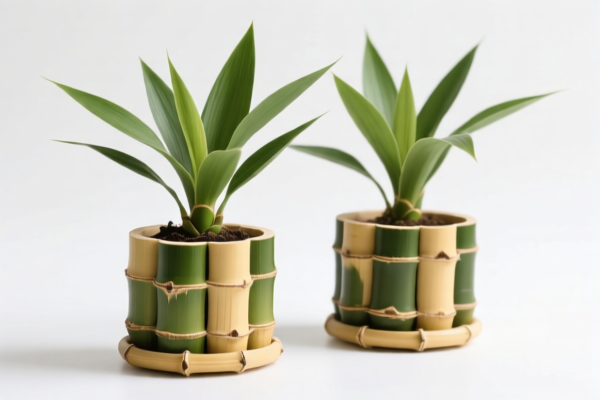| HS Code | Official Doc | Tariff Rate | Origin | Destination | Effective Date |
|---|---|---|---|---|---|
| 4419110000 | Doc | 33.2% | CN | US | 2025-05-12 |
| 4419120000 | Doc | 33.2% | CN | US | 2025-05-12 |
| 6909900000 | Doc | 59.0% | CN | US | 2025-05-12 |
| 6914908000 | Doc | 60.6% | CN | US | 2025-05-12 |
| 1301909190 | Doc | 37.5% | CN | US | 2025-05-12 |
| 1302390090 | Doc | 40.7% | CN | US | 2025-05-12 |




Bamboo Pot
A bamboo pot is a container, traditionally crafted from bamboo, utilized for a variety of purposes, most commonly in horticulture and decorative applications.
Material
The primary material is bamboo, a fast-growing, renewable grass known for its strength, flexibility, and aesthetic appeal. Different species of bamboo are used, influencing the pot's thickness, color, and overall durability. Often, the bamboo is treated to enhance its resistance to decay and insect infestation. Modern variations may incorporate bamboo composites or combine bamboo with other materials like wood or metal for added strength or design elements.
Purpose
- Planting: The most common use is as a container for growing plants, both indoors and outdoors.
- Decoration: Bamboo pots are frequently used as decorative items, valued for their natural aesthetic and contribution to minimalist or Asian-inspired designs.
- Tea Ceremony: Specific types of bamboo pots are integral to traditional tea ceremonies, used for holding water or serving tea.
- Cooking: Smaller bamboo pots can be used for cooking rice or other foods, particularly in Asian cuisines.
Function
The primary function is containment – holding soil and providing a suitable environment for plant roots. Bamboo’s natural breathability allows for good air circulation, which is beneficial for many plant species. The pot provides structural support for the plant and facilitates drainage. In decorative applications, the function is primarily aesthetic.
Usage Scenarios
- Gardening: Suitable for a wide range of plants, from herbs and succulents to small trees and shrubs.
- Indoor Decor: Used in living rooms, bedrooms, patios, and balconies to add a natural element and display plants.
- Balconies and Terraces: Lightweight and relatively durable, making them suitable for outdoor use on balconies and terraces.
- Asian-Inspired Settings: Commonly used in gardens, tea rooms, and homes with Asian-inspired decor.
- Hydroponics: Some bamboo pots are specifically designed for hydroponic systems.
Common Types
- Traditional Round Pots: Classic cylindrical shape, often used for bonsai or other ornamental plants.
- Square/Rectangular Pots: Provide a more modern aesthetic and can be arranged in groupings.
- Slotted Pots: Feature slots or openings for improved drainage and aeration, often used for orchids or other epiphytes.
- Bonsai Pots: Specifically designed for bonsai trees, with shallow depths and drainage holes.
- Tea Ceremony Pots (Chawan): Variations designed for specific tea ceremony rituals, often with unique shapes and glazes.
- Bamboo Root Pots: Constructed from sections of bamboo root, offering a rustic aesthetic.
- Composite Bamboo Pots: Combining bamboo with other materials like wood or plastic for increased durability and weather resistance.
Bamboo pots fall under classifications related to tableware, kitchenware, or potentially agricultural receptacles, depending on their specific use. Here's a breakdown of relevant HS codes based on the provided information:
- 4419110000: This code covers “Tableware and kitchenware, of wood: Of bamboo: Bread boards, chopping boards and similar boards”. While not directly a pot, if the bamboo pot is used for food preparation (e.g., as a serving dish or for holding ingredients), this could be applicable. The total tax rate is 33.2% (Base tariff: 3.2%, Additional tariff: 0.0%, Post-April 2, 2025: 30.0%).
- 6909900000: This code covers “Ceramic wares for laboratory, chemical or other technical uses; ceramic troughs, tubs and similar receptacles of a kind used in agriculture; ceramic pots, jars and similar articles of a kind used for the conveyance or packing of goods: Other”. If the bamboo pot is used for agricultural purposes (e.g., planting), this code might be considered. The total tax rate is 59.0% (Base tariff: 4.0%, Additional tariff: 25.0%, Post-April 2, 2025: 30.0%).
- 6914908000: This code covers “Other ceramic articles: Other: Other”. If the bamboo pot is not used for laboratory, chemical, or agricultural purposes, and is considered a general ceramic article, this code could be applicable. The total tax rate is 60.6% (Base tariff: 5.6%, Additional tariff: 25.0%, Post-April 2, 2025: 30.0%).
According to the provided reference material, the HS code options related to 'bamboo pot' are limited, with only the following 3 found.
It is important to determine the specific use of the bamboo pot to ensure accurate classification. If the pot is used for food preparation or serving, 4419110000 may be the most appropriate code. If it is used for agricultural purposes, 6909900000 should be considered. If it is a general ceramic article, 6914908000 may be applicable.
Customer Reviews
No reviews yet.